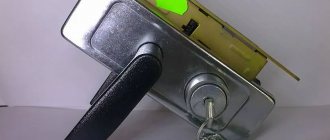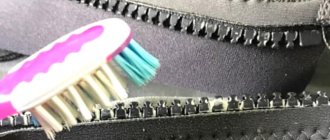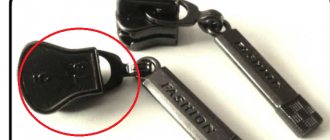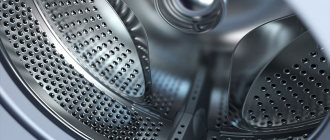A key breaking in the core of a lock is an extremely unpleasant occurrence, especially if you want to keep the lock, and you also have spare keys. A stuck key fragment not only prevents you from opening the lock, but can also render it completely unusable.
Fortunately, there are ways to deal with this problem using available means. We bring to your attention ten ways to remove a broken key from the core of a lock.
Types and characteristics of locks
The following types of locks are distinguished:
1. By type of fastening:
- Mounted. These are locks, the fastening of which is carried out by threading the bow into the eyes. Padlocks are easy to install and replace. However, they have rather low burglary resistance. Scope of application: sheds, warehouses, basements, garages.
- Mortise. These are the most commonly used locks, installed directly inside the door leaf. It is advisable to embed them into metal doors, where they are protected from drilling by a sheet of metal. The locking mechanism must have high resistance to tampering, secrecy, reliability and durability.
- Invoices. Installed on the surface of the door leaf. Can be used for wooden and metal structures. They are characterized by ease of installation, repair and replacement, but they are not sufficiently resistant to hacking attempts.
2. By type of locking mechanism:
- Crossbars (rack and pinion). Inside them there is a crossbar with teeth and machined grooves. These locks have low burglary resistance, so their use to protect valuable items is not recommended.
- Level ones. This is the most reliable type of lock with a secret part in the form of plates (levers). The larger the lever, the more reliable the lock (preferably 6-8). Often, lever locks can be combined with other security systems.
- Cylinder. The design of the lock includes a mechanism consisting of a cylinder, a cylinder and a lever mechanism. Cylinder locks are characterized by high reliability. They are single- or double-sided, single- or double-row.
- Code ones. Used to protect gates, access doors and interior spaces. They do not require a key, but due to their low security level their use is limited.
- Electromechanical. They are similar in design to traditional mechanical locks, but can be opened and closed remotely. They can be mortise or overhead.
Causes of jamming
There can be many reasons for the locking mechanism to jam; among the most common are:
- foreign objects getting into the keyhole;
- contamination of the castle with dust and small debris;
- attempts to unlock the door in the wrong way;
- inflating the wood web;
- skew;
- defects made during the production process;
- sting blocking;
- use of a duplicate key made with defects.
Attempts to open it through manipulation
If outside manipulations are performed on the door that are not provided for by the manufacturer, the lock may jam or break. Try to handle door leaves carefully, without subjecting them to unusual loads. This will extend their service life, and you will not have to waste time opening locks.
Foreign objects entering the well
Foreign objects getting into the keyhole most often occurs due to children's pranks. They do not realize that the lock is a fragile mechanism that can be easily damaged.
Well contamination with dust or mechanical shavings
The lock cylinder is such a fragile thing that it is not necessary to insert foreign objects into it for problems to occur. It is enough to clog the keyhole with dust, and the lock will jam. If you handle keys made of low-quality metal carelessly, microscopic shavings will get into the mechanism, which also interferes with the normal functioning of the door.
Inflating a wooden door leaf
If there is high humidity in the room and the door is made of wood, the mechanism may malfunction due to deformation of the material. To avoid this, try to ventilate the room and prevent liquid from getting on the wooden surface.
Use of the unlocking device for purposes other than its intended purpose
Keys are often used not only for opening locks, but also for outside manipulation, as auxiliary tools. This disrupts their shape, which negatively affects interaction with the locking mechanism.
Chips and scratches remain on the surface of the metal, where dirt collects. When it comes into contact with the keyhole, it remains inside, which speeds up the process of clogging it.
Strong slamming of a metal or wooden door
When problems arise when opening doors, many do not try to find and eliminate the cause of their occurrence. Instead, they start slamming the door, using excessive force. This approach negatively affects the integrity of the object and internal mechanisms, accelerating their destruction.
Warp door leaf
Unfortunately, not all manufacturers approach their business with due responsibility and attention. Some hastily designed door structures cannot withstand their own weight and become deformed after installation.
This causes the locking mechanism to jam, preventing the rightful owners from getting inside the apartment.
Using a low quality duplicate key
When using duplicate keys made from low-quality materials, it is possible:
- clogging of the keyhole with metal shavings;
- the key, when opening, may break, getting stuck inside the cylinder;
- Damage to the inside of the mechanism due to the key not fully matching the original.
The pin falls out of the mechanism and the tip gets blocked
Pins are pins in the lock mechanism that ensure its reliability and security. The pins themselves are quite fragile and, if you do not follow the operating rules of the mechanism, they will begin to collapse faster. This will lead to jamming or breakage of the lock, which will complicate entry into the room.
Tools for the procedure for obtaining a piece of the key
In order to get a broken key out of a door lock, you will need some tools that you can borrow from a neighbor, if this is not a private house with a garage.
- Thin screwdriver - regular and figured;
- An awl is a tool for stitching shoes and other items;
- A jigsaw is a small saw;
- Hairpin for pinning hair;
- A nail puller is a hand tool;
- Pliers and hammer;
Necessary tools to remove the key
- Medical tweezers;
- Drill, possibly using a grinder.
Methods for removing a broken key from a lock
Methods for extracting key fragments are divided into three main types:
- Gentle, during which the metal fragment is removed without damaging the lock mechanism;
- Damaging. The main task of this method is to disassemble the lock. In most cases, after disassembling the lock, the cylinder with a jammed or broken key is replaced, after which the mechanism is assembled and installed in the door without any problems. But there are some locks that either cannot be reassembled or cannot be disassembled. In this case, you will have to install a new mechanism;
- Breaking. They are used in situations where it is impossible to disassemble the lock without damaging the door leaf. Therefore, after breaking it out, it is necessary to change not only the locking mechanism, but also the fittings, and also, in some cases, the entire door.
Gentle methods
You should always start with gentle methods. In this case, the fragment is removed without damaging the locking mechanism. Thus, the lock remains intact, and you can subsequently use it for its intended purpose.
Before proceeding with removal, apply some lubricant into the keyhole. Machine or gun oil, WD-40, brake fluid, and even any vegetable oil are suitable for these purposes. Using a syringe or other available tools, carefully place a few drops of oil into the lock. The liquid will wash the core from dust and improve the sliding of the fragment.
How to extract the key?
- If a piece of the key sticks out of the hole, you are lucky. This is the simplest of all possible options. Take tweezers, small pliers or pliers and try to grab the protruding piece with them. Squeeze the broken piece tightly and try to remove it by gently vibrating and moving the broken key from side to side. At the same time, try tapping the lock a little - the vibration will help move the stuck piece out.
- If the door is open, try to “knock” the piece out of the keyhole. To do this, tap the lock on the opposite side with a hammer. The vibration will help the broken piece come out. This method is perfect for a padlock. How to do it correctly, watch the video.
- Try inserting two thin awls into the gap between the keyhole and the key. This is done from opposite sides: from both sides or from above and below. Grab a piece of the key with an awl and, using light, rocking and vibrating movements, try to remove it.
- Take a thin jigsaw file and insert it into the lock with the notches facing up. Rotate the saw to catch the chip. Then smoothly and carefully pull out the file along with the stuck piece.
- If you broke your key after returning from fishing and you have gear with you, a fishing hook will come to your aid. Unbend it, insert it into the lock so that the notched tip catches the fragment and pull it towards you. This method is quite labor-intensive and requires patience, but in half the cases it is successful.
- The last method is within the capabilities of a real “jeweler”. You need to drill a hole in the end of the stuck piece and screw a self-tapping screw into it, without damaging the keyhole. Then, holding the screw head, pull the broken piece out of the lock.
All actions must be performed without haste and carefully. In this case, you have a chance to get the key and not make the situation worse. If gentle methods do not help, you need to use heavy artillery.
Removing the lock by removing the cylinder
It happens that gentle methods do not help and you have to completely remove the larva. There are proven “barbaric methods”, after which a complete replacement of the door lock is necessary:
- knocking out the cylinder. There is an armor plate on the back of the door. It needs to be removed along with the screws and hit with a hammer on the protruding part of the cylinder;
- prying the core. It is pryed off with an awl, a thin screwdriver or a hairpin. Using any tool, you need to lift the pins in the secret mechanism and release the rest of the key;
- drilling out the cylinder. It is drilled over the keyhole, turned and removed;
- removing the lock from the end. The method is used with the door open, when the key fragment does not protrude from the hole. The lock is removed and taken apart.
Using extreme measures
When the key in the door lock breaks and other methods do not help, the owner is forced to agree to extreme measures. As they say, you need to grit your teeth and break down the entrance, because it is impossible to get into the apartment in any other way.
Most often, the bolts of locks are cut off if they are visible in the gap that exists between the door leaf and the frame. The crossbars are cut with a grinder or a hacksaw. Lock cutting is used in critical situations when the door urgently needs to be knocked down. Usually, after this the door leaf has to be completely changed.
When working, it is necessary to take into account the features of modern door designs. Not all modern doors can easily cut off the hinges with a grinder. There are structures equipped with a protective mechanism and anti-removal bolts, which cannot be cut.
What is not recommended to do
In some situations, they try to glue key fragments together with glue. However, this method is ineffective, since there is a possibility of the fragment becoming jammed, which further complicates the matter. Also, chemical elements may get inside the lock, which will require replacing the cylinder.
Gentle methods
How to remove a broken key from the cylinder? This can be done in the following ways:
- Self-tapping screw. Applies only to thick keys. It involves drilling a hole at the break point and screwing a self-tapping screw into the lock. Then the self-tapping screw is grabbed with pliers and removed along with the fragment.
- Jigsaw file. This is one of the most effective ways. The file must be inserted under the key and turned so that the teeth are located on top. The fragment is grabbed and removed.
- Fishing hook. This is a rather difficult but effective method. To remove the remains of the key, unbend the hook by inserting the serrated tip into the hole. When the key is engaged, you must carefully pull it towards you.
- Pliers. Pliers are in demand when there is a large piece of debris protruding from a keyhole. First you need to lubricate the lock, and then pull out the key. Everything must be done carefully, without using excessive force.
- Vibration. This technique is recommended if the key inside the disc lock breaks. First, the pins are lubricated. Next, using a thin screwdriver, the code elements are installed in their original position. Then the lock is tapped with a hammer. Under the influence of vibration, the fragment is pulled out and removed using pliers.
- Pulling out the fragment with a metal tube. Recommended for lever locks. You need to take a copper or brass tube that fits onto the protruding pin. Next, you should melt its end with a soldering iron and attach it to the fragment. After hardening, the tube must be pulled out along with the broken key.
Unusual ways to remove a broken key from a lock
If the key is broken, you can open the door using one of the unusual methods. Even professionals use them:
- A brass tube is placed on the fragment and heated with a soldering iron. After the tube has cooled, part of the key is removed in the usual way;
- the tip of the bent fishing hook is inserted into the slot and the rest is fished out. The method is suitable when the fragment has gone deep into the keyhole. The main thing is to hook it with the barb of a fishing hook, and then carefully pull it towards you;
- The two parts of the key are glued together with superglue and pressed tightly against each other. After a few minutes of waiting, the entire key is removed from the lock cylinder. Broken keys, even if they are firmly glued, can no longer be used.
In what cases will a magnet help?
A powerful neodymium magnet will only help you if the key is made of iron. Brass products that are now made for modern locks are not attracted to a magnet.
Keys made of brass most often break because they are not reliable and cannot withstand increased load
What to do if the padlock is jammed?
Padlock mechanisms are located outdoors and are always exposed to the external environment. If the key in a padlock is broken, you can use the vibration method by tapping the lock with a hammer. In this case, you must act carefully so as not to damage the bow. The rest of the key may fall out due to vibration, and the lock will remain intact.
Sometimes the key doesn't break, but simply gets stuck inside the lock and won't turn. Since the internal elements of suspended structures rust, machine or vegetable oil helps to activate them.
Oily substances reduce friction between parts. If that doesn't work, take some spray lubricant and generously lubricate the inside of the lock through the hole. After this, try to insert the key and turn it alternately to the right and left. The lock must be held with your hand to keep it stationary.
In humid and frosty weather conditions, it happens that a lot of moisture gets into the padlock mechanism. It turns into ice and prevents the key from moving. In this case, ordinary hot water can save the situation. The castle is generously watered with it, then treated with lubricant or oil. Usually this is always effective, and even an old rusty mechanism begins to work properly.
If conditions permit, the unruly castle is placed in an active chemical composition. You can use all types of gasoline, acetone solution, weak acids, vinegar, diesel fuel. These substances dissolve rust and successfully combat corrosion phenomena.
You should not expect instant results: it will take several hours or even days to achieve the effect. After chemical exposure, any mechanism begins to work well.
Who to turn to for help if you can’t open the door yourself
When you can’t open the doors without professional help, you should contact the housing office or the building management company. Usually, specialists arrive an hour after the application is accepted. At first they use gentle methods. If they turn out to be ineffective, you have to resort to hacking, cutting off the hinges or removing the lock from the door leaf.
After the specialists arrive, the owner of the apartment or house must be prepared for the fact that he will be asked for documents proving his identity. It’s good if your passport or driver’s license was not left in a locked apartment. When renting residential premises, tenants must call the owner and ask him to come, taking with him the necessary documents.
Calling specialists from the housing office or the building management company will not have consequences in the form of material expenses for a tenant who finds himself in a critical situation. As a last resort, you can use the paid services of commercial organizations.
Advertising leaflets with their phone numbers are always found in mailboxes or on entrance doors. Specialists from a commercial organization also have the right to demand documents from a person, but there are companies that operate without these requirements.
Some commercial firms provide further services after a forced break-in of a residential premises. For a fee, they can install a new lock or a new door.
How to prevent the key from breaking in a door lock?
Each of us can find ourselves in such a situation. In order to avoid it, you need to be more attentive to door locks, handling them with care and precision. If the lock jams, it will continue to do so in the future. Eventually it will jam completely. If the internal mechanism is jammed, it is better to repair it as quickly as possible without delaying the matter.
From time to time you need to pay attention to the condition of the key. If it begins to bend and its teeth become thin, you should replace it with a new one. It is better to throw away old keys immediately.
For preventative purposes, the lock is washed and lubricated once a year. Kerosene or gasoline is used for washing, and effective silicone-based sprays can be used as a lubricant. They protect small parts of the secret mechanism from rust and prevent small dust particles from penetrating inside. You can also install a metal flap at the larva.
Proper care of the lock and timely replacement of keys will help you avoid being in a situation where the key suddenly breaks and the lock stops working. The lock must be handled with care so as not to damage its secret mechanism and not be left outside at the wrong time.
Possible causes of the malfunction
- Manufacturing defects.
- As a rule, these are the consequences of its illiterate installation, and problems with the lock appear quite quickly.
- Increased wear of parts. By the way, this often happens if “not native” keys are used, but duplicates. Moreover, they are made according to the sample without removing and disassembling the locking device.
- Keyhole clogged.
- Neglecting the requirements for periodic lubrication of the mechanism.
- Gradual deformation (distortion) of the door block or leaf. This is the case when thinking about how to open a jammed lock is a waste of time. Most likely, you will have to either remove the canvas or cut off the loops (depending on their type).
- The defects are in the key itself. Many people use it not only for its intended purpose, but also as an improvised screwdriver, bottle opener, and the like. Naturally, over time, such a key in the lock becomes more and more difficult to turn, and at a certain moment (usually the most inopportune one) it jams.
- Hacking attempt.
Next, you should evaluate the complexity of the malfunction and your capabilities.
For example, if a metal door is jammed, then you obviously cannot do without a special tool. And you will definitely need outside help. If it is wooden and fairly new, then solving the problem by knocking out the canvas is also inappropriate. And only after analyzing all the factors can you make a rational decision on what to do in the event that the door is deformed or the lock is broken.
How to remove a broken key from a car
It is hardly surprising that drivers are often interested in the question of how to get a broken key out of a car. Not all cars work with a keyless entry system or with starting the engine from the Start Stop button.
Therefore, in order to get into the car, you first need to insert and turn the key in the door lock. Next, when you intend to drive, you still have to insert the key into the ignition, turn it over and drive off.
The reasons why it ultimately becomes necessary to remove a broken key from a car door lock or ignition can be different:
- frozen water inside the door lock;
- inaccurate turning;
- mechanism jamming;
- lock malfunctions;
- low quality of the metal of the key itself;
- using excessive force, and so on.
Seeing that one piece is left in his hands, and another piece of the key is stuck in the door, the main question that arises in the driver’s mind is how to get it out of the car now.
The locking device does not work well: preventive measures
To avoid problems with jammed locks, preventive measures must be taken. These include:
- Clean the door lock regularly. To do this, it will have to be disassembled. This is done with the door leaf open. Cleaning is performed every two years.
- Periodically lubricate with machine oil or special liquid. It is recommended to do this every time after cleaning. Lubrication is also carried out as needed. Experts advise doing it at least once every two years.
- Check the serviceability of the hinges. Adjust them if necessary to avoid distortion of the door leaf.
- From time to time, inspect the locking device and replace worn elements.
- Open and close the locking system carefully.
It is important to install imported locking systems. They are of better quality and last longer. You need to buy a device with a guarantee and check its performance before paying, inspect the case.
Use of hand tools
If one key is broken, there is usually no serious problem. In most cases, the motorist has a spare key. It’s just that you won’t be able to use it. To do this, you will first have to get rid of the debris. Look into the lock itself where the key is stuck.
Consider yourself very lucky if a piece of a broken device is partially visible from the outside. That is, the metal protrudes beyond the level of the lock itself, and is not stuck deep inside.
Although the rod protrudes from the lock, it still sits quite tightly inside the larva. This is not felt when the key is intact, since the gripping area is quite large. The effort of a few fingers is enough to remove without problems.
Only part of the rod remains here. It is unlikely that you will be able to grab it with your fingers and pull it out. Also, try not to drive the sting even deeper into the larva with your rash actions.
To remove a broken key that is stuck in your car door, you can use:
- multitool;
- pliers;
- pliers;
- powerful tweezers;
- long-nose pliers;
- mechanical spider;
- side cutters;
- with wire cutters.
The idea here is to firmly grasp the protruding metal part of the stuck key, and then begin to gradually pull it out.
If you manage to pull out the fragment, do not rush to throw it away. It’s better to leave it so you can give it to the master and make an exact duplicate. This is especially true for those who do not have a spare key for one reason or another.
Bad advice
Some “craftsmen” advise using super glue when opening it, supposedly capable of gluing torn pieces of metal together. Of course, the “method” is flawed. Even the best glue is not able to bind two fragments together enough to pull the piece out. Often the fragment becomes jammed, which makes removal more difficult. The situation can be worsened if chemical elements of the glue get inside the lock. Then it will not be possible to remove the fragment “painlessly”, and the larva will have to be replaced.
Another unfortunate example is the proposal to remove the key using a steel wire. In some cases, this can actually work, but it will require considerable skill.
Alternative Methods for Removing a Stuck Key
Alas, not everyone is so lucky. It often turns out that the key is broken and stuck quite deep in the car lock. As a result, it will no longer be possible to grab the protruding part with the tool.
The situation is such that the key in the lock broke at the root and remained inside the cylinder. There is now no access to the inside of the car, or the ability to close the car. We need to come up with something.
There are several options for how to remove a piece of your car key that is stuck in the door if we are talking about deeper-lying remains.
You can correct the situation using:
- thin metal wire;
- jigsaw files;
- superglue and soda.
Now about each option in more detail.
Metal thin wire
The wire needs to be thin enough to fit into the existing gap, but also strong enough to withstand the tension when trying to remove the remaining metal.
The bottom line is this:
- find wire of suitable sizes and parameters;
- make a long tail that you will hold on to and pull later;
- make a tiny hook at the end, literally 3-4 millimeters;
- insert the wire into the gap between the groove and the fragment;
- try to catch on to the protrusion of the key;
- gently pull towards the exit of the lock.
Under no circumstances should you rush here. You may have to pull out the remaining keys from the cylinder, millimeter by millimeter at a time. Therefore, immediately be patient.
Plus, not every wire will be suitable, since when caught, the hook may align itself, and thus the element will not be pulled out.
Jigsaw file
An excellent device option if you don’t know what to do if the key in your car lock suddenly breaks and you can’t get hold of it with pliers.
If there are deeper residues that can still be caught from the inside, a file from a regular jigsaw will help. Both manual and electric. The advantage is the presence of teeth on this device. That is, you won’t have to make an additional hook.
The idea is to insert the file into the lock, use the tooth to hook the protruding part of the key and pull it towards you.
As in the previous case, take your time. Pull gradually, pulling the key out millimeter by millimeter. Only patience and your own accuracy will help you here.
Just keep in mind that the method with a metal wire, like with a jigsaw file, is only suitable for situations where the key gets stuck in the neutral position. That is, in cases of relatively easy pulling out.
Super glue and soda
The situation looks somewhat different when the key not only breaks, but the driver also managed to turn it before that. And here a natural question arises about how to open the car in such a situation.
And here a fairly old but extremely effective life hack will help you, as it is now fashionable to say. To work on removing the debris, you will need to take superglue, as well as regular baking soda.
Many people have probably heard and know about the use of quickly hardening and setting glue, but they do not quite understand what soda has to do with extraction.
Everything is easy to explain here. The combination of glue and soda gives a stronger and stronger connection. In fact, baking soda enhances the effect of superglue.
The extraction process itself looks like this:
- pour glue into some container;
- prepare a small amount of baking soda;
- find a tool that is suitable in length and size so that it is easy to insert it into the lock;
- dip a tool, a flat screwdriver with a thin blade, into the glue;
- then sprinkle baking soda on top;
- carefully insert the screwdriver into the lock;
- make sure you hit the metal debris exactly;
- hold the tool like this for a while so that the glue has time to set;
- When the desired level of setting is achieved, remove the remaining key.
The advantage of this method is that the connection is really strong. That is, you can not only get the remaining metal from a broken key, but in some cases even turn it.
Although it’s not worth taking risks and experimenting here. The main task is to remove the broken tip. And to open and close doors, or turn the ignition switch, it is better to use a spare key or a duplicate one.
Solution
Tools for removing a broken key: screwdrivers, awl, hammer, pliers.
Two types of methods are used to solve the problem. The first involves removing an object, and the second involves breaking the door lock.
There is a possibility that even after the successful use of one of the preserving methods, destructive ones will still have to be used.
This may be necessary when there is no second key or when the key in the lock is broken due to the failure of the code mechanism, and normal opening is impossible.
Saving methods
To be sure, you should wait about 20 minutes. so that the lubricant penetrates the joints of the mechanism and the key that has broken in the lock.
In the simplest case, if the key in the lock breaks so that its core protrudes slightly from the hole, you need to try to carefully but firmly grab the end of the fragment with pliers. Rocking the clamped instrument in a circular motion and from side to side, pull it towards you. If you managed to get it, then you were lucky.
In a situation where the key in the lock is broken and you can barely see it, you can try using tweezers instead of pliers. The sequence of actions remains the same. Due to the fact that it is difficult to grasp well with tweezers, these manipulations have less chance of success.
For a disk mechanism, before removing the fragment, you need to use a thin screwdriver or a pin to turn all the code elements and the fragment itself counterclockwise until it stops. They must line up in the tunnel. Next, lightly tapping the back of the screwdriver on the end of the cylinder creates vibration in it, which promotes the movement of the debris to the exit. It should move to a more comfortable position for gripping.
Scheme for removing a broken key.
For steel keys, using a magnet may help. You can check the magnetism of a material by looking at its residues. The magnetized end of a good professional screwdriver will do. The cheap Chinese one has too little gravity.
A jigsaw blade can provide good fixation. You need to first break off the fastening end. The blade is wound along the rod with the teeth towards it and with the teeth sloping towards themselves, turns with the hooks towards the object being removed and is pulled out. This is done several times until a positive result.
If there is no such result, there is one last way to save the code mechanism. Provided that the key has broken in a fairly massive section, and there is an area of at least 2*2 mm on the broken part, you can try drilling a hole with a diameter of 1.5 mm in it and screwing a self-tapping screw into it. As the edge of the hardware sharpens from the hole, the fragment is loosened and removed.
Destructive methods
With a tightly seated piece of debris, there is nothing left to do but crack the code mechanism. The armor plate, if there is one, can be cut off with a hammer and chisel. The grip of a nail puller is placed under the head of the self-tapping screw and pulled up with force. At this point, either the fragment will be pulled out, or the core of the mechanism will be removed. All that remains is to turn the cam with a screwdriver and unlock the door.
If there is nowhere to screw in a self-tapping screw, but you have a drill with a drill with a diameter of 6-10 mm, you can drill out the cylinder mechanism along the part where the fixing pins are located, or directly through the core. It is advisable to drill carefully so as not to damage the cam. If this happens, you will have to ruin the screwdriver. Bend its end about a centimeter and apply it to the response mechanism of the lock.
You can do without a drill. When the cylinder mechanism is installed incorrectly and protrudes beyond the lining by more than 5 mm, it is easy to hook it with a gas wrench or screws and twist the end. Then just empty out the contents and use a screwdriver to open the door lock.
If the secret is installed correctly, you will have to damage not only it, but also the lock escutcheon. It is undermined with a chisel, a nail puller is inserted into the gap and the overlay is torn off. Then the cylinder protruding beyond the plane of the door is twisted with a key.
It is worth knocking the cylinder inward only in the absence of a gas wrench, chisel or nail puller. The cylinder cam can be rotated. Therefore, when knocked out, it can damage the inside of the lock. Not only will it have to be changed, but the lock may no longer open. It’s easy to knock off the protruding end of a cheap secret with a chisel, scoop out the insides with a screwdriver and use it to open the lock.
The fact that the key is broken indicates wear of the mechanism or key. The cause may also be contamination of thin joints with dirt and wear products. Such a cylinder makes you aware of a future problem through fuzzy operation and jamming. It is better to take care of solving the problem in advance and not lead to a breakdown.











